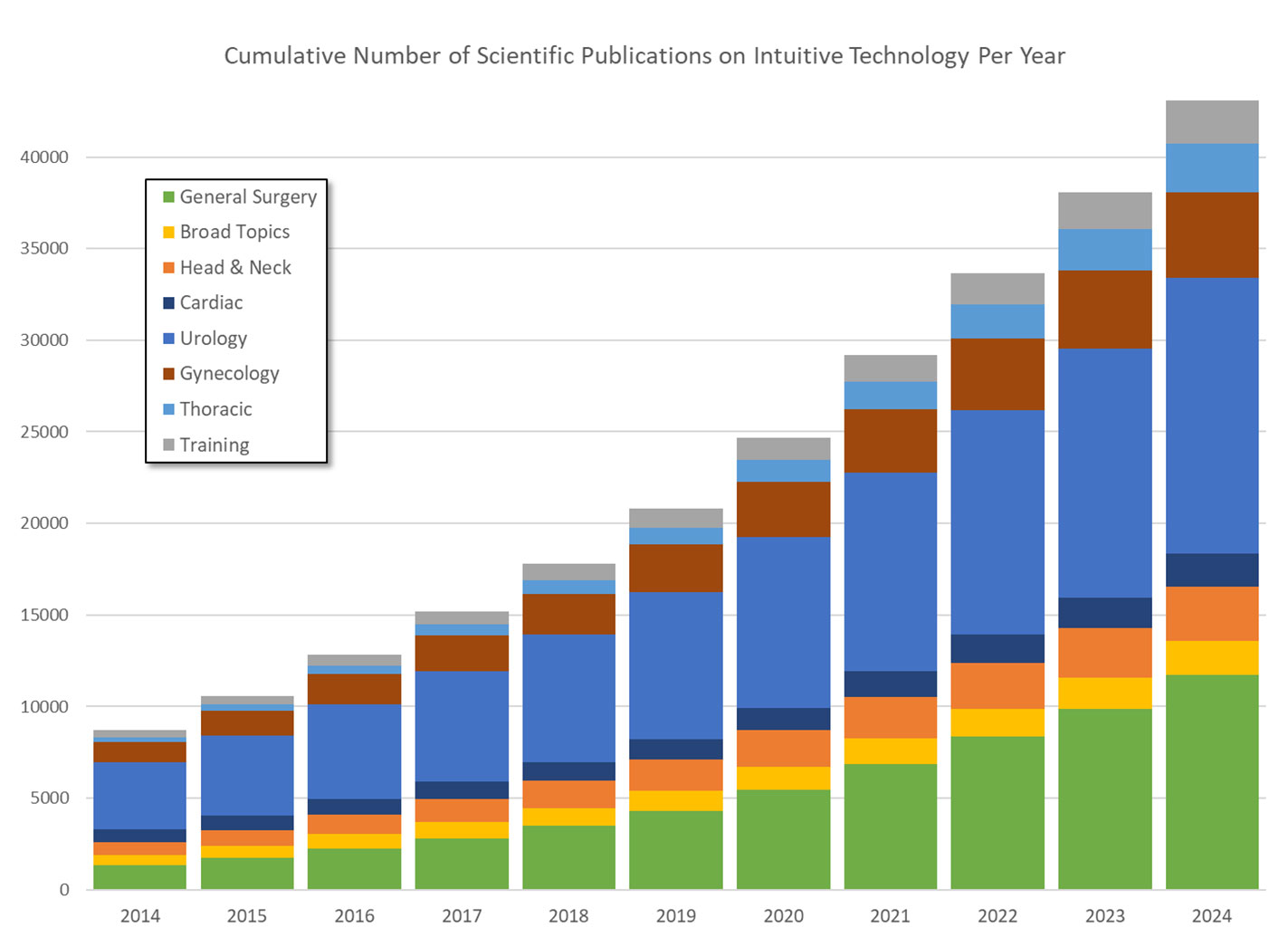
Da Vinci Research and Outcomes
The science behind evidence-based care
Intuitive supports the generation of high-quality clinical evidence through sponsored and collaborative research initiatives. We work with clinicians, hospitals and medical/surgical societies to uncover the benefits of Intuitive technologies while maintaining a patients-first mindset and help contribute to the body of knowledge about minimally invasive care.
Sponsored and collaborative research includes multicenter studies and key opinion leader partnerships. We also conduct early feasibility studies, product and indication approval studies, post-approval observational outcomes research, clinical registries, and analyses of real-world evidence (RWE) databases. Examining outcomes data helps generate evidence showing value to patients, surgeons, physicians, societies and other key stakeholders.
Our research includes but is not limited to studies across procedures, bariatrics, colorectal, general surgery, gynecology, thoracic, urology and patient access. We also conduct platform specific studies for systems such as da Vinci SP and the Ion endoluminal system.
Maturing clinical evidence
A large-scale systematic literature review and meta-analysis covering the period 2010-2022 is now available for your reading. These results are based on the COMPARE study and recently published in the Annals of Surgery. This meta-analysis of the global literature represents 22 countries, 7 different oncologic procedures including 230 peer-reviewed publications, covering over 1.1 million robotic cases with the da Vinci surgical systems, over 1 million lap/VATS cases and over 1.6 million open cases. This study highlights the clinical value of robotic-assisted surgery using the da Vinci surgical system and will help inform evidence-based decision making by physicians, health care providers, payors and policy makers.
Across Procedures research
Impact of type of minimally invasive approach on open conversions across ten common procedures in different specialties
Healthcare Resource Utilization After Surgical Treatment of Cancer: Value of Minimally Invasive Surgery
Prospective analysis of 164 fires of the SureForm stapler in oncological cases
Robotic Technology in Emergency General Surgery Cases in the Era of Minimally Invasive Surgery
A study of the use of robotic surgery for outpatient surgery to determine the effect on recovery (MAYFLY)
Bariatrics research
Out-of-Pocket Costs among Commercially Insured Individuals with type 2 Diabetes and Obesity: Comparison between Ozempic and Sleeve Gastrectomy
Type 2 diabetes remission after bariatric surgery and its impact on healthcare costs
Prospective study on revisional bariatric surgery
Colorectal research
Right Colectomy Evidence Navigator
Rectal Resection (LAR/TME/ISR) Evidence Navigator
Sigmoidectomy for Diverticular Disease Evidence Navigator
ANCOR study on right colectomy
SureForm stapler study for colorectal procedures
The impact of operative approach on postoperative outcomes and healthcare utilization after colectomy
A national database propensity score-matched comparison of minimally invasive and open colectomy for long-term opioid use
Outcomes comparison of robotic-assisted versus laparoscopic and open surgery for patients undergoing rectal cancer resection with concurrent stoma creation
Practical consensus statements for surgical management of rectal cancer cases
Prospective analysis of 246 fires of da Vinci SureForm SmartFire stapler in colorectal cancer: First Indian study
General Surgery research
Ventral Hernia Repair Evidence Navigator
Inguinal Hernia Repair Evidence Navigator
Cholecystectomy Evidence Navigator
A retrospective study of laparoscopic, robotic-assisted, and open emergent/urgent cholecystectomy
Prospective multicenter study of short-term outcomes after complex cholecystectomy
New persistent opioid use following robotic-assisted, laparoscopic and open surgery inguinal hernia repair
Laparoscopic intra-peritoneal onlay mesh plus versus robotic transabdominal pre-peritoneal for primary ventral hernias
Current landscape of minimally invasive pancreatectomy for neoplasms
Retrospective acute care appendectomy study
Gynecology
Hysterectomy Endometrial Cancer Evidence Navigator
Hysterectomy Cervical Cancer Evidence Navigator
Hysterectomy Benign Evidence Navigator
Endometriosis Resection Evidence Navigator
Myomectomy Evidence Navigator
Robotic assisted benign hysterectomy compared with laparoscopic, vaginal, and open surgery
Next GENERATion of GynEcological Surgery—robotic-assisted surgery in gynecological indications (GENERATE)
Reproductive outcomes following robot-assisted laparoscopic myomectomy: 10 years experience
Thoracic research
Thymectomy Evidence Navigator
Lobectomy Evidence Navigator
Lobectomy: PORTaL study analysis
Lung Cancer Robotic Comparative Study (LARCS)
Urology research
Radical Prostatectomy Evidence Navigator
Partial Nephrectomy Evidence Navigator
Systematic literature review of cost-effectiveness analyses of robotic-assisted radical prostatectomy for localized prostate cancer
One year healthcare costs after robotic assisted and laparoscopic partial and radical nephrectomy: a cohort study
Cost-effectiveness of robotic-assisted radical prostatectomy for localized prostate cancer in the UK
Da Vinci 5 research
A prospective post-market study to understand the utility of instruments with Force Feedback technology in Robotic Procedures Using Da Vinci 5 Robot
Evaluation of forces applied to tissues during robotic-assisted surgical tasks using a novel Force Feedback technology
Novel Force Feedback technology improves suturing in robotic-assisted surgery: a pre-clinical study
Da Vinci SP U.S. IDE Clinical Studies
The representative procedures presented under the Investigational Device Exemption (IDE) studies are not 510k cleared and the safety and effectiveness of the product for these listed procedures has not been established. These procedures are currently not available in the U.S.
Single-port system IDE study for nipple-sparing mastectomy
Single-port system IDE study for thoracic procedures
A prospective, multicenter, single-arm clinical study was conducted to evaluate the performance and safety of the da Vinci SP surgical system (Intuitive) for thymectomy through a subxiphoid incision.
Note: Study completed and 510(k) clearance obtained.
Digital Product research
Evaluating Intuitive 3D Models in preoperative surgical planning for thoracic and colorectal procedures
Patient Access research
Minimally Invasive Surgery Deserts: Is There a Role for Robotic Assisted Surgery?
Rates of Minimally Invasive Surgery After Introduction of Robotic-Assisted Surgery for Common General Surgery Operations
SureForm Stapler research
Clinical and Economic Outcomes of Using Robotic Versus Hand-Held Staplers During Robotic Lobectomy
Thirty day outcomes for laparoscopic versus robotic sleeve gastrectomy: Does the stapler matter?
Use of Lower Staple Heights in Robotic Sleeve Gastrectomy
